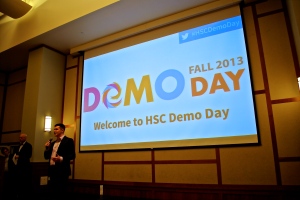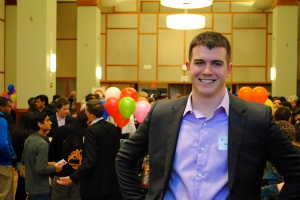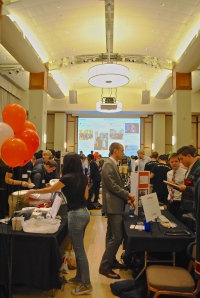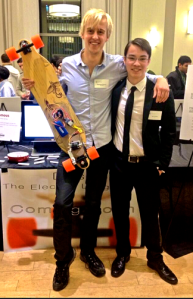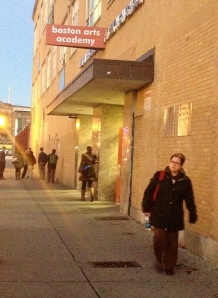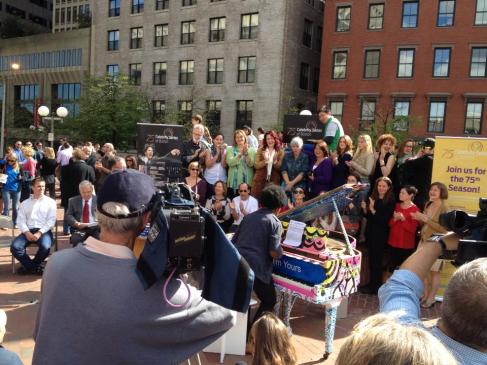After being drugged by an odorless, colorless and tasteless substance in his drink, Michael Abramson decided to develop a line of cups and straws that detect date-rape drugs. Companies with founders like Abramson of DrinkSavvy have become a major part of the rise in interest in entrepreneurship.
“You really can’t imagine what it’s like to slowly lose consciousness before you’ve even finished your first drink,” said Abramson, 31, founder and chairman of DrinkSavvy. “My friends were able to get me home safely, but you wake up from a situation like that and it’s kind of scary.”
Following his own experience at a popular Boston club, Abramson began doing research on color-changing date-rape drug testing strips.
“That’s where I kind of came up with the ‘aha’ moment of, if the same cups, straws and stirrers that you were already drinking from were also the color-changing indicator, then you get the continuous, effortless and discreet monitoring of your drink throughout the entire night. And that’s what gave birth to DrinkSavvy.”
Abramson is among the many that take part in the highest level of entrepreneurial activity this country has seen since 2005, according to the Global Entrepreneurship Monitor (GEM) U.S. Report. Additionally, the study found that younger adults are more likely to start a business.
Dan Gregory, co-director for the Center for Entrepreneurship Education at Northeastern University and faculty adviser to IDEA, Northeastern University’s Venture Accelerator believes that the rise in entrepreneurship is in response to the country’s economic decline and rise in technology.
“When I graduated from college, there were large companies with training programs and you would leave college and then spend six months in the training program and you would go on into the company, “said Gregory. “And those things are really hard now. It’s much harder to find work in companies. Companies hire and fire all the time. The combination of computing power in your hand with being able to start a Web-Based company for almost no money means that people are taking control of their own destiny.”
University-aged students are intrigued by the success stories of those like Abramson and are seeking education in entrepreneurship to help them reach their own achievement. The Young Entrepreneur Council of more than 1,600 Americans ages 16 to 39 found that among those ages, 88 percent believe that entrepreneurship education is important.
“I think the process is becoming a little bit more idolized with shows like ‘Shark Tank,’” said Matt Voska, Northeastern sophomore computer engineering and entrepreneurship major.
ABC’s show “Shark Tank” is a competition to look for and invest in the best business a panel of judges believes America has to offer.
“Everyone wants to see the rags-to-riches kind of story,” said Voska. “You hear about Facebook, Mark Zuckerberg, from his dorm room, he’s going from nothing to a multi-billionaire.”
Voska was the director of this year’s Husky Startup Challenge and Demo Day where Northeastern students were given the opportunity to start their own business and compete for a grand prize of $2,000.
“It’s really the dream, that passion that entrepreneurs have in them. They have this vision and then they have the passion the make it happen,” said Voska. “We’ll teach them how to turn that though, that idea that you write on a napkin and make it a reality.”
Lars King, Northeastern sophomore marketing and entrepreneurship major and Entrepreneurs Club board member, also believes strongly in gaining knowledge and experience in entrepreneurship.
“I naturally come up with so many ideas all the time that I want to actually have the business experience and knowledge so that after college I can successfully lead a business,” said King. “Entrepreneurship is risky and a lot of them fail, but if you learn the best practices, get the most data, do everything in the most intelligent way, it’s actually a much more educated guess.”
Patricia Nolan-Brown, inventor of the Rear-Facing Carseat Mirror and other projects and author of the new book “Idea to Invention,” believes that now is the perfect time to become an entrepreneur. Virtually anyone has the ability to be one as long as they polish certain skills,” she said.
“I think that you have to learn how to get a voice if you’re on the quiet side. You have to be a salesperson. You have to be a manufacturer,” said Nolan-Brown, who is based in Lexington. “You have to be the one in the garage, up all night. But it’s a passion. And if you don’t have that passion, you’re not going to be a good entrepreneur.”
Gregory believes, “the passion has to be there to fuel it. But the passion alone is inadequate.”
“I think there’s three pieces,” said Gregory. “There’s passion that you’re born with. There are tools that you can learn and the experience. Actually doing it.”
In terms of tools, Gregory believes that there are some essentials.
“I think a little bit about finance and accounting is critical,” Gregory said. “Learning about legal incorporation and legal rights and the employees. Learning about how you set up an ownership structure for a venture. Learning how to take it to market with social media and the different channels that are available today. All that stuff can be learned.”
Gregory said that students in his courses are often surprised by how difficult it is to begin their own business.
“You’ve got to do everything yourself. Everything takes time,” said Gregory. “People aren’t quite as quick as you want them to be to join your company. It takes longer to develop the product and service. It costs more and you don’t have money and nobody wants to invest money because you don’t have any track record. There are these incredible highs and lows, and you’ve got to endure both.”
As a result of the increase of entrepreneurial education programs and cultural of acceptance of entrepreneurs, the number of entrepreneurs has increased.
“I think it’s harder because it’s so competitive,” said Gregory. “It’s so easy to get into business now because there are so many more people competing for the same customer.”
Brendan Walker, former CEO of Bon Hiver and current CEO of DrinkSavvy, has faced that exact competition and struggle within his own previous company.
After attending West Point and Dartmouth College for a finance and business MBA, Walker began a freebase snowboard bindings company that lasted three years before he decided he had to set it aside.
“To put it akin to someone’s baby, I know it seems a little odd, but it really is,” said Walker. “When you have to face the fact that you’ve got to pull the plug on your own venture. It’s extraordinarily tough because you live, eat and breathe this entire business every day for years.”
Walker said making this kind of decision is difficult because the nature of the business is so unpredictable.
“You never know,” said Walker. “Because you never know if you’re a week away or two weeks away from an investment that turns everything around. Or getting that purchase order or getting that contact from an inquirer or a joint venture. So I think that is the hardest part, knowing when to hold on to the opportunity and when to put it on the shelf.”
Walker believes that although his first business may not have made it, his education helped him make the decision to step away from the project for now and move on to one that is quickly picking up. However, he does not feel that an education in a classroom will fully prepare people for the real world.
“All these things you can’t anticipate down the road, it’s almost impossible for a program to teach something comprehensive where every entrepreneur is going to encounter these situations,” said Walker. “You use lessons that are taught in the classroom. So, I took classes in entrepreneurship but I have to say, 90 percent of what I’ve learned was actually starting my own business and running it.”
“I always joke and say a compass and an MBA are very similar. Just because you have a compass doesn’t mean you’re a navigator. But it sure as hell helps you find your way there,” said Walker. “An MBA, for instance, for an entrepreneur, I think is like that compass because it points you in the right direction.”
Walker agrees with the recent and says that he too finds younger people are becoming more interested in entrepreneurship. He, as well as others, attributes it to a few factors, one being the reaction to the economy.
“A lot of people are getting their educations going through undergraduate and graduate school, thinking the jobs are going to be there. That you can rely on the system to put you in a nice place. And if anything, we’ve been taught recently that there’s nothing to rely on. I think the self-reliance of the next generation is one of the most contributing factors that sprung from the financial crisis.”
Northeastern’s Entrepreneurship week and Husky Startup Challenge in particular encourages that self-reliant generation to begin something on their own.
Ian Carlson, sophomore design major, recently won Northeastern’s Demo Day grand prize of $2000 for his electric longboard kit that he designed and developed completely on his own. Although Carlson grew up with a father who is heavily involved in startups, he did not have any entrepreneurial experience or education prior to joining Entrepreneurs Club or Demo Day.
But after developing his own product, Carlson said he is definitely considering taking on the new entrepreneurship minor.
“If you have an idea, don’t be afraid to spend time and develop it,” said Carlson. “It doesn’t hurt to try and see what happens.”
Behind each entrepreneur is a different motive to begin a business but one underlying reason seems unanimous. Abramson of DrinkSavvy spoke of the wish to break the mold of a traditional career.
“I think a lot of it has to do with differentiating each other from one another,” said Abramson, 31. “A lot of people don’t necessarily feel fulfilled by being a ‘cog in the machine’, so to speak, and they want to build something of their own that they can call their own.”
